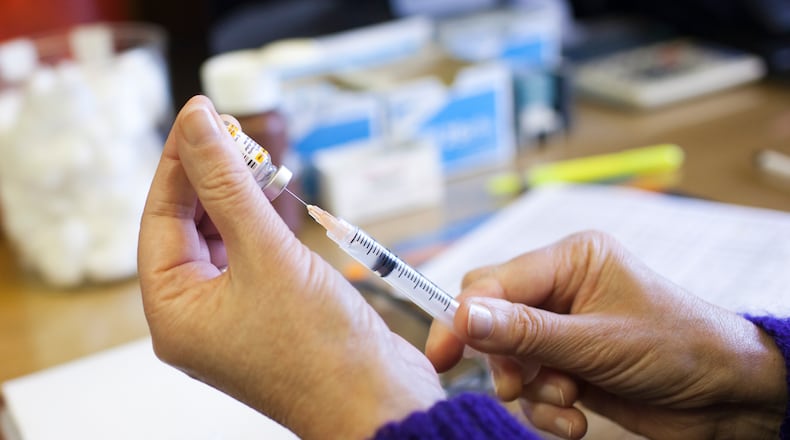Ohio’s flu activity, from outpatient and ER visits for flu-related symptoms to confirmed flu hospitalizations, is above the five-year average for this time of year, according to ODH.
Illnesses pick up
Butler, Clark and Montgomery counties are seeing an uptick in respiratory illnesses, including the flu.
People should follow influenza precautions to avoid getting and spreading illnesses, such as through frequent hand washing, staying home when sick and getting vaccinated, health experts said.
“If you have symptoms of a respiratory illness, such as a cough, fever, or sore throat, avoid going to work or public places to prevent spreading it to others,” said Dan Suffoletto, public information manager for Public Health - Dayton and Montgomery County.
Respiratory illnesses are also picking up in southwest Ohio.
“Butler County has seen a significant rise of flu in recent weeks, and we’ve also observed similar increase in the influenza viral gene copies we monitor at both the Oxford and Hamilton City Waste Water Treatment Plants,” said Butler County Health Commissioner Erik Balster.
Increasing viral concentrations in wastewater is often a leading indicator of eventual higher transmission, higher case counts and hospitalizations in the community, Balster said. Since around mid-January, Butler County has seen an increase in the level of influenza gene copy rates in treatment plants.
“These rises are running in parallel with the observed increase in school absenteeism throughout multiple Butler County school districts, flu-related hospitalizations and positive cases we are made aware of,” Balster said.
Clark County is seeing an increase in the influenza virus being detected in wastewater samples, according to the Clark County Combined Health District. The region is “well above” the five-year average for flu-related hospitalizations and ER visits for flu symptoms, the health district said.
Hospitals filling beds
Hospitals across Ohio have filled about 73% of their total available inpatient beds, including ICU beds, the majority of which are with non-COVID patients, according to the Ohio Department of Health. About 2% of the beds are COVID-positive patients.
Credit: JIM NOELKER
Credit: JIM NOELKER
Similar trends are being seen in the Dayton and Springfield region, as well as in southwest Ohio, including Butler and Warren counties, according to ODH data.
Miami Valley Hospital has seen significant wait times for its ER, according to its website, which has shown recent wait times of more than two hours.
All of Premier Health’s hospitals are experiencing an increase in both inpatient and ER visits, according to a spokesperson. This is due to flu and other respiratory illnesses and COVID.
Kettering Health hospitals have shown wait times anywhere from 20 minutes to more than an hour and a half, according to its website.
“Like other local health systems, Kettering Health has experienced an increase in emergency department visits and patient volumes for influenza-like illnesses, with the highest volume and acuity this last week,” Kettering Health said in an organizational statement.
Kettering Health is encouraging people to continue following practices to minimize the spread of respiratory illnesses and to get a flu shot. Patients can also visit a primary care provider or a Kettering Health On-Demand Care location for testing or mild symptoms such as congestion, cough or low-grade fever.
“Kettering Health has procedures in place to manage these surges in patient volumes, helping ensure our patients receive appropriate care,” the health system said.
Mercy Health has observed a significant increase in influenza A cases since the start of January, a spokesperson for Mercy Health - Springfield Regional Medical Center said.
From last week to this week, positive cases have surged by 86%, the spokesperson said.
In regard to hospital capacity, Mercy Health said it is not seeing anything that’s out of the norm for this time of year.
Other healthy precautions
In addition to staying home when sick, people should avoid close contact with people who are sick or exhibiting symptoms such as coughing and sneezing.
“Wash your hands with soap and water for at least 20 seconds, especially after being in public places or touching surfaces that may be contaminated,” Suffoletto said.
If soap and water are not available, use a hand sanitizer that contains at least 60% alcohol, he said.
Other good hygiene practices include covering your mouth and nose with a tissue or the elbow of your arm when coughing or sneezing to prevent the spread of germs. People should also disinfect frequently touched surfaces like phones, doorknobs, light switches and keyboards.
Be cautious in if you are in a high-risk environment, Suffoletto said.
“If you work in places like healthcare facilities, public transportation or other high-traffic areas, take extra precautions such as wearing a mask, using hand sanitizer, and disinfecting items you come into contact with,” Suffoletto said.
About the Author


